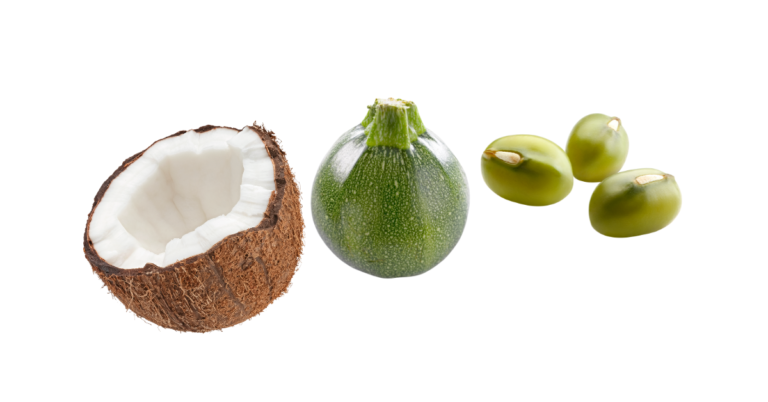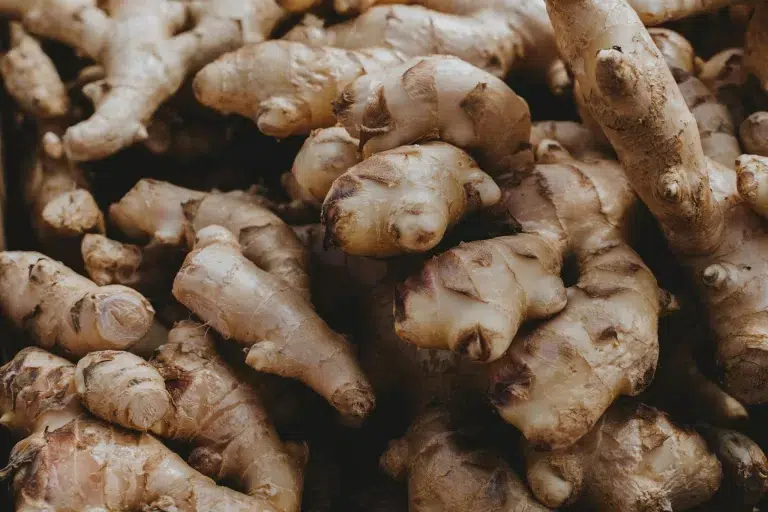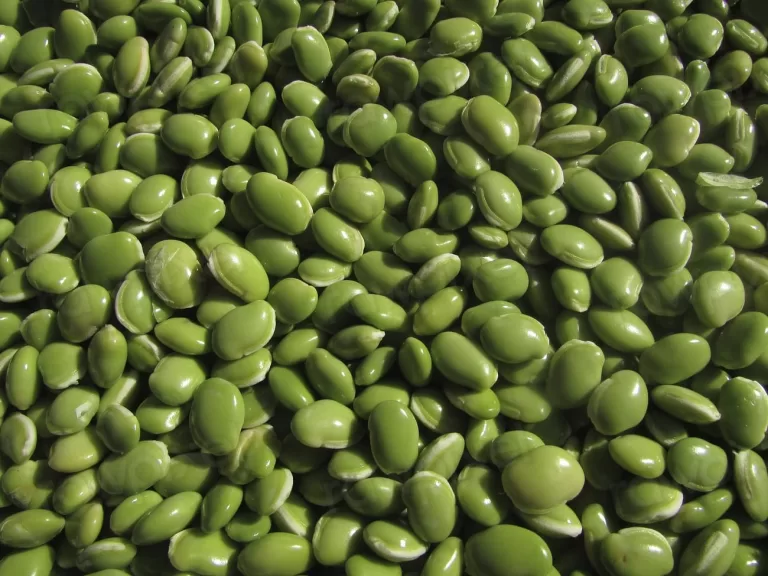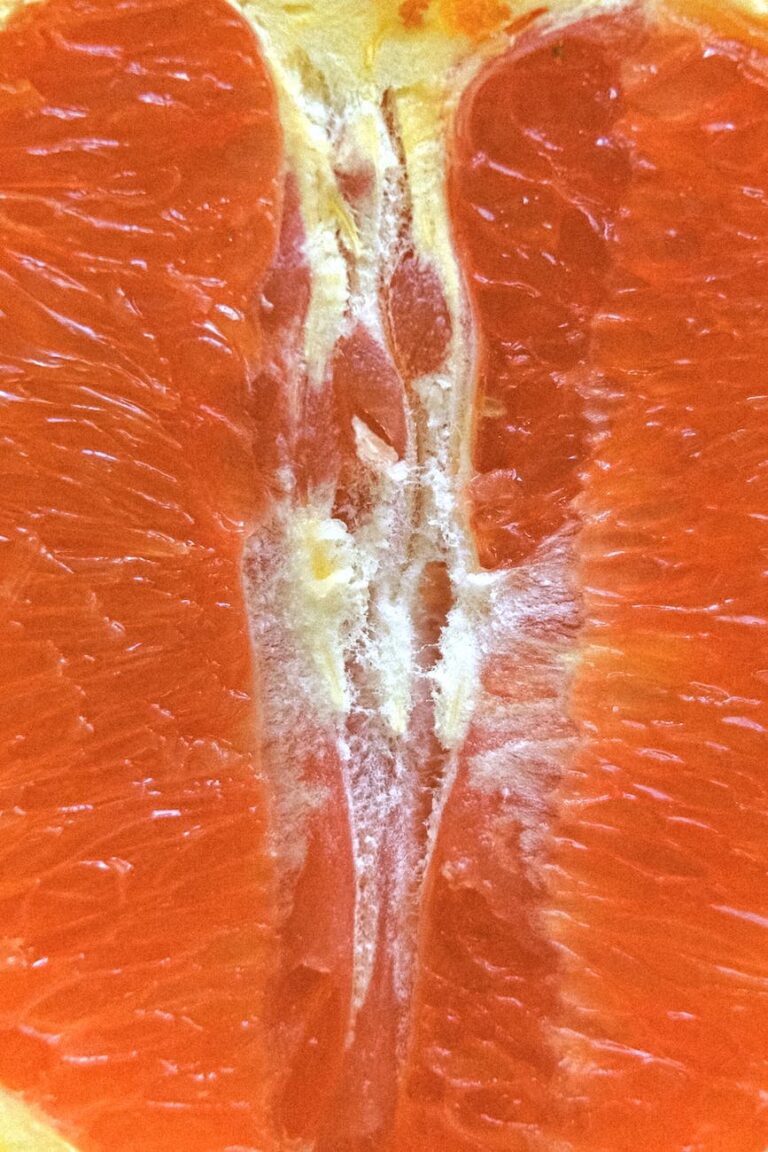Lemon Grass The Medicinal Use In Better Self Care
Lemongrass, botanically known as Cymbopogon, has several therapeutic properties when consumed as a food source and in other therapies.
For instance, its phytotherapeutic properties include soothing digestive issues, alleviating discomfort, bloating, stomachaches, and indigestion, and relaxing the nervous system.
It is associated with anxiolytic actions.
Traditional sciences use lemongrass in tea and essential oil to reduce stress. Additionally, Ayurvedic science categorises lemongrass as a calming nerve tonic because it encourages nervous system relaxation.
Key Points In This Article
This article provides an overview of Lemongrass, its bioactive compounds, related case studies on therapeutic actions, and an Ayurvedic overview.
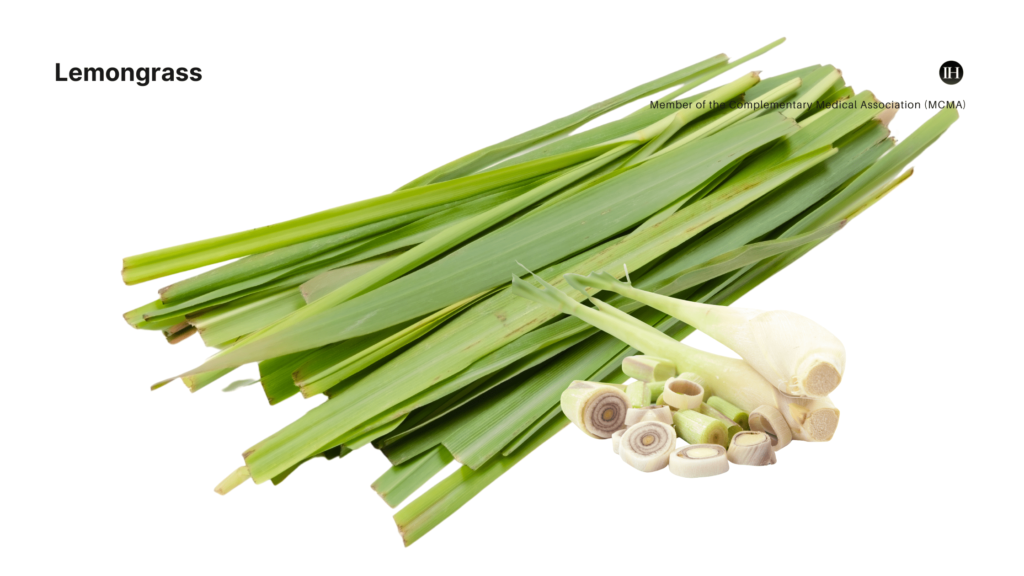
Lemongrass Overview
Lemongrass is a perennial plant, which essentially means it lives for more than two or several years. It belongs to the grass family and the genus Poaceae.
It is primarily grown in Asia, South America, Australia, and other warm regions.
The botanical name of lemongrass, “Cymbopogon,” is derived from the Greek words “kymbe” and “pogon,” meaning “boat” and “beard,” respectively.
Physical Characteristics
Regarding its physical characteristics, Lemon grass is tall with slender stems and a grass-like appearance.
- The leaves are vibrant green, and the green hue may subtly vary depending on climatic conditions and region, such as moisture, soil, temperature, etc.
- Lemongrass belongs to the grass family Poaceae which is a plant species.
Aroma
Lemongrass’s refreshing, citrusy scent is both invigorating and uplifting. It imparts a vibrant fragrance, making it a popular choice in various settings.
The other Names of Lemongrass
Lemon grass is known by different names depending on region; for instance, it is called cochin grass. Cochin refers to a location in India.
Cochin Grass
Malabar Grass
Citronella Grass
Fever Grass
Barbed Wire Grass
In addition, Lemongrass comprises of 180 species, such as Cymbopogon citratus, Cymbopogon flexuosus, Cymbopogon winterianus, Cymbopogon martinii, Cymbopogon nardus, and Cymbopogon refractus.
India has established a dominant position in the production and exportation of lemongrass.
The port of Cochin in India is the largest global export hub for lemongrass.
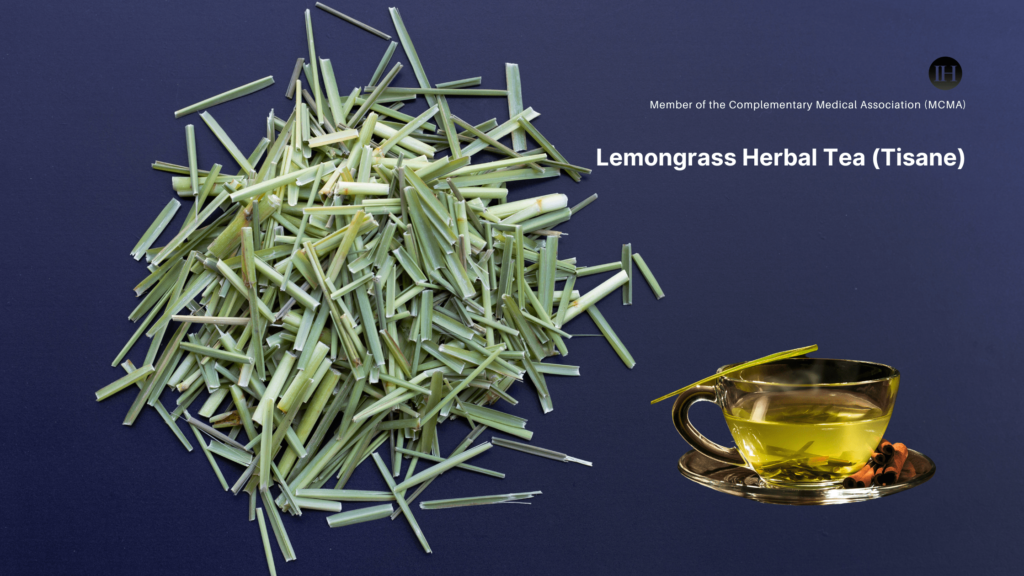
Bioactive Compounds In Lemongrass
Lemongrass is widely used for its therapeutic properties attributed to the presence of various bioactive constituents.
One prominent group of compounds found in Lemongrass is terpenes and terpenoids.
These compounds include both cyclic and acyclic monoterpenes, such as geranial and limonene, among others.
1. Terpenoids
Terpenoids, or isoprenoids, are diverse organic compounds abundantly present in various botanical specimens.
These compounds exhibit significant prevalence within the plant kingdom and play crucial roles in various biological processes.
One of the main functions of terpenoids in plants is their involvement in producing essential oils. In lemongrass, geranial and limonene are some terpenoids.
Terpenoids have demonstrated anti-inflammatory properties.
Terpenoids Therapeutic & Pharmacological Properties
According to Thoppil RJ and Bishayee A. (2011), terpenoids elicit a diverse range of effects, including reducing oxidative stress, suppressing inflammation, inducing apoptosis, regulating the cell cycle, inhibiting cell proliferation, and modulating various signal transduction pathways.
Notably, compounds such as d-limonene, cucurbitacin B, ursolic acid, β-carotene, and lycopene have been identified for their specific contributions.
Terpenoids are potent anti-inflammatory and memory enhancers.
Terpenes
Terpenes are hydrocarbons, while terpenoids are modified terpenes that have undergone oxidation.
For instance, terpenes are responsible for strong odours, while terpenoids may have additional functional groups. Both have diverse applications in medicine, industry, and culinary uses.
2. Other Compounds In Lemongrass
Lemongrass species consist of several essential components.
The study by Mukarram et al. (2021) on “lemongrass essential oil components with antimicrobial and anticancer activities,” Lemongrass components include neral, isoneral, geranial, isogeranial, geraniol, geranyl acetate, citronellal, citronellol, germacrene-D, and elemol.
Collectively, these constituents constitute approximately 60-80% of the bioactive elements found in lemongrass.
3. Other Micro Constituents
Furthermore, It is also categorised as a source of sustenance and animal feed, owing to its abundant micronutrient content. It contains essential micronutrients such as vitamins A, C, and E.
Lemon Grass includes vitamins A, C, E, folate, niacin, and riboflavin, protein, antioxidants, and mineral nutrients
Main compounds in Lemongrass Essential Oil
Similarly, lemongrass main components, along with its wide range of bioactive compounds, include citral and geraniol, which are found in its essential oil.
Due to these compounds, Lemongrass has a high citral content and a strong lemon-like fragrance. The essential oil of lemon grass is one of its uses due to its cytotoxicity effect on human cancer cells suggested by studies.
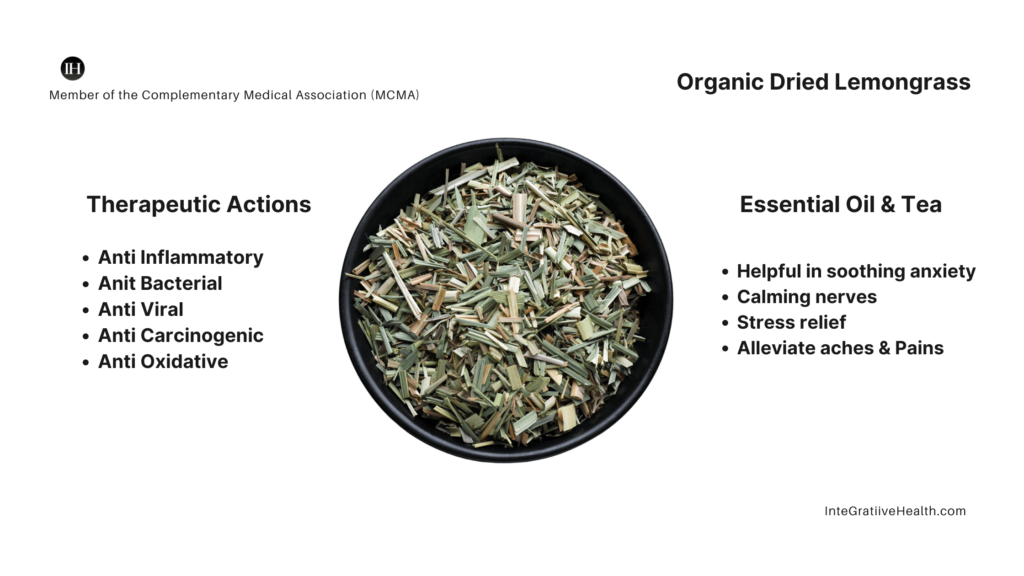
Therapeutic & Pharmacological actions
Subsequently, Mukarram et al. (2021) study states that lemongrass compounds contain antifungal, antibacterial, antiviral, anticancer, and antioxidant properties.
The next section explores particular therapeutic actions of lemongrass in more detail.
1. Anxiolytic Actions, Lemongrass & Nerves
The plant possesses the potential to alleviate anxiety and stress-related biomarkers. In disciplines such as Ayurveda, it is utilised as a nerve tonic for stress and overall well-being.
Ayurveda links the nervous system to be dominantly impacted by vata dosha.
Moreover, in terms of scent and how it affects our sense of smell and nervous system, a study titled “Effects of Olfactory Stimulation with Aroma Oils” suggests that “olfactory stimulation with aroma oil has a stabilising effect on the prefrontal cortex and brain activity and reduces systolic blood pressure.”
This suggests a clear connection between the therapeutic impact of lemongrass aroma and its traditional medicinal uses, as recognised by scientific research.
Here Is An Chart Depicting Olfactory Stimulation:
| Stimulation of Olfactory Influence on stress & nerves |
|---|
| Nose |
| First Cranial Nerve Instrumental in sense of smell |
| afferent sensory nerve fibers |
| considered a component of the central nervous system |
Regarding physical effects, stress “relief” has a releasing effect and often triggers sedation, a deep relaxing sleep when carried out with particular aromas and phytotherapeutics.
2. Lemongrass Aroma Anti Stress Actions
The Mukarram et al. (2021) study reported that lemongrass aroma positively impacted certain stress-related conditions, such as reducing anxiety, alleviating subjective tension, promoting calmness, and inducing a sedative effect.
Method: Inhalation Or Application
These effects were observed when lemongrass aroma was systematically administered through inhalation or application.

3. Rheumatoid Arthritis: Pain Blocking Actions
Similarly, lemongrass is also used to relieve rheumatoid arthritis to some degree.
According to (Shah et al., 2011), lemongrass has antinociceptive properties, which means it can block painful stimuli.
The antinociceptive descending system includes the midbrain, the medulla, and the spinal cord. Its anti-inflammatory properties also help relieve pain.
In a 2005 study by Dr. Sue Chao, it was found that lemongrass oil is one of the top six essential oils with anti-inflammatory properties.
Lemongrass oil has a modulating effect when applied or used in a hydrotherapy setting. When incorporated into a well-balanced personal routine, lemongrass may help manage and alleviate certain types of aches and pains.
Additionally, the effect of lemongrass on an individual is influenced by their Ayurvedic Prakriti.
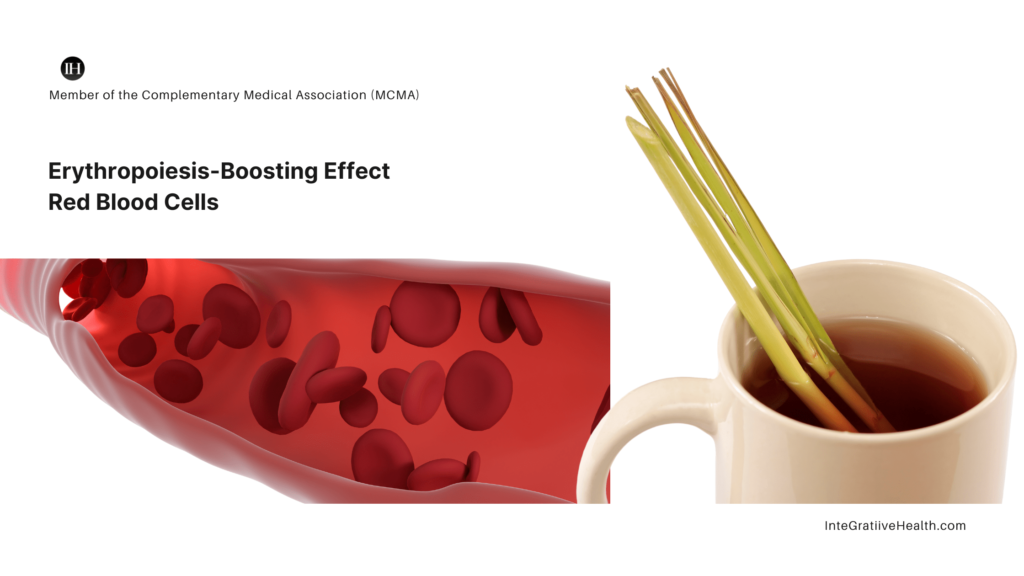
4. Potential Red Blood Cells Boosting Effect
Lemongrass is associated with being helpful in anaemia.
An infusion of C. citratus leaf seems to benefit erythropoiesis, likely due to its nutritional constituents, antioxidant properties, and pharmacologic effects.
Erythropoiesis is a process within our body that produces red blood cells.
According to a study by Ekpenyong, Christopher E et al. (2015), the bioactive natural constituents of lemongrass tea and its potential erythropoiesis-boosting effects were highlighted in their Journal of Medicinal Food article.
Here Are Some Key Points Of The Study:
- After receiving an infusion prepared from 2, 4, or 8 g of C. citratus leaves once daily for 30 days, a comparison was conducted between the results obtained on days 10 and 30, and the baseline values.
- The infusions contained tannins, saponins, alkaloids, flavonoids, and various macro- and micronutrients derived from C. citratus leaf powder. This led to a significant increase in the levels of packed cell volume (PCV), haemoglobin (Hb), and red blood cells (RBC) in all participants.
- This effect was particularly notable during the subchronic phase of the study.
The table below Details the different phases cited in the study:
Baseline phase (1 day)
Acute phase (10 day)
Subchronic phase (30 day)
(Ref: evaluation phases for bioactivity of a phytotherapeutic)
Terms Associated With Lemongrass Properties
The following section outlines the therapeutic properties of compounds found in lemongrass, including live plants, dried herbs, fresh tea, dried tea, and essential oils.
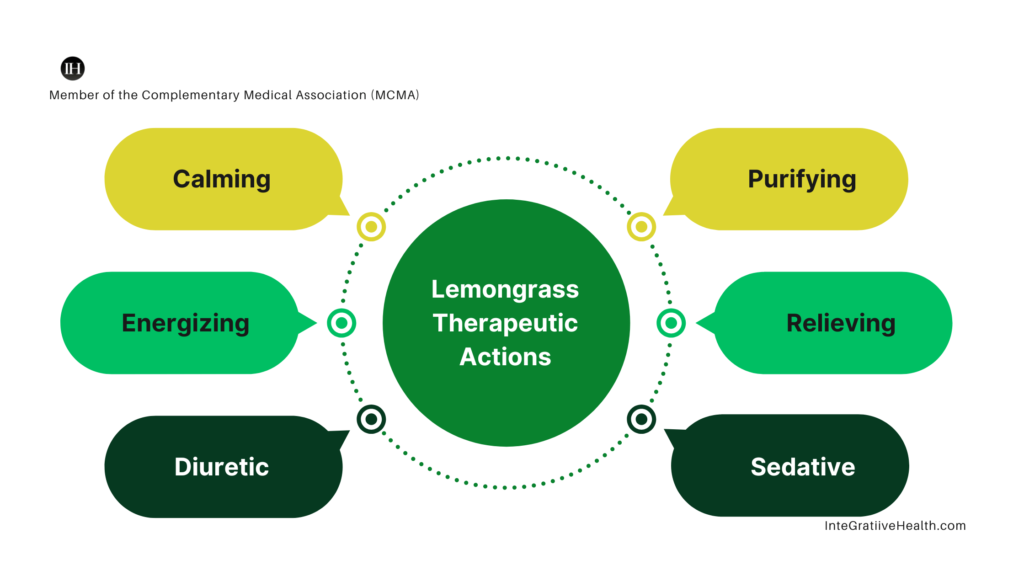
Essential Oil of Lemongrass has shown the following actions:
Below is a table detailing the various therapeutic actions of lemongrass compounds as described by Mukarram M, Choudhary S, Khan MA, Poltronieri P, Khan MMA, Ali J, Kurjak D, Shahid M in their work “Lemongrass Essential Oil Components with Antimicrobial and Anticancer Activities.”
| antimicrobial | antifilarial | insecticidal | analgesic | anti-hypertensive | cardioprotective |
| antimicrobial | antifilarial | miticidal | aesthetic | anti-obesity | haematological properties |
| anticancer | antitussive | antirheumatic | anti-inflammatory | anxiolytic | antiamoebic |
| antiseptic | acaricidal, larvicidal | antioxidant | anti-mutagenicity potential, | antidiarrheal | antinociceptive |
Ayurvedic Overview of Lemongrass: Vata & Kapha
According to Ayurveda, lemongrass has several therapeutic actions in balancing the Vata and Kapha doshas, which are two vital energies in the body.
- Additionally, Ayurveda associates vata imbalances with arthritic conditions
- Imbalances in kapha are associated with problems such as weight gain
Hence, lemongrass might aid in alleviating symptoms associated with Vata or Kapha imbalances, which co-relates to some of the studies cited in the former sections of this article.
Summary
Lemongrass is a recognised plant in the Cymbopogon genus. Its botanical name is Cymbopogon citratus, and it is known for its strong citrus aroma.
It contains several recognized therapeutic properties due to its terpenoids and other bioactive compounds, such as geraniol, citral, limonene, and linalool.
These compounds have anti-inflammatory, antimicrobial, and antioxidant effects, making them a valuable natural remedy for various issues. Several studies, such as Mukarram et al. (2021) conducted a study on lemongrass essential oil components and their antimicrobial and anticancer activities.
Lemongrass has been studied for its capacity to block pain in arthritic conditions, calming the nervous system, helpful in anaemia and more.
Ayurvedic sciences suggest it helps balance vata and kapha conditions.
Precautions & Suitability
Precautions and personal responsibility are paramount. If something is suitable or not, make an informed choice, seek the advice of a professional.
This is an informational post only and does not constitute professional advice.
References in this article
Mukarram M, Choudhary S, Khan MA, Poltronieri P, Khan MMA, Ali J, Kurjak D, Shahid M. Lemongrass Essential Oil Components with Antimicrobial and Anticancer Activities. Antioxidants (Basel). 2021 Dec 22;11(1):20. doi: 10.3390/antiox11010020. PMID: 35052524; PMCID: PMC8773226.
Thoppil RJ, Bishayee A. Terpenoids as potential chemopreventive and therapeutic agents in liver cancer. World J Hepatol. 2011 Sep 27;3(9):228-49. doi: 10.4254/wjh.v3.i9.228. PMID: 21969877; PMCID: PMC3182282.
Masyita A, Mustika Sari R, Dwi Astuti A, Yasir B, Rahma Rumata N, Emran TB, Nainu F, Simal-Gandara J. Terpenes and terpenoids as main bioactive compounds of essential oils, their roles in human health and potential application as natural food preservatives. Food Chem X. 2022 Jan 19;13:100217. doi: 10.1016/j.fochx.2022.100217. PMID: 35498985; PMCID: PMC9039924.
Meenapriya M, Dr. Jothi Priya. “Effect of Lemongrass Oil on Rheumatoid Arthritis.” Saveetha Dental College and Hospitals, Chennai.
Sharma K, Akre S, Chakole S, Wanjari MB. Stress-Induced Diabetes: A Review. Cureus. 2022 Sep 13;14(9):e29142. doi: 10.7759/cureus.29142. PMID: 36258973; PMCID: PMC9561544.
Thoppil, Roslin J, and Anupam Bishayee. “Terpenoids as potential chemopreventive and therapeutic agents in liver cancer.” World journal of hepatology vol. 3,9 (2011): 228-49. doi:10.4254/wjh.v3.i9.228
Horticulture India: https://nhb.gov.in/model-project-reports/Horticulture%20Crops/Lemongrass/Lemongrass1.htm#:~:text=India%20is%20the%20largest%20producer,West%20Europe%2C%20U.S.A.%20and%20Japan.
Shah G, Shri R, Panchal V, Sharma N, Singh B, Mann AS. Scientific basis for the therapeutic use of Cymbopogon citratus, stapf (Lemon grass). J Adv Pharm Technol Res. 2011 Jan;2(1):3-8. doi: 10.4103/2231-4040.79796. PMID: 22171285; PMCID: PMC3217679.
Terpenoid: https://en.wikipedia.org/wiki/Terpenoid
Masyita A, Mustika Sari R, Dwi Astuti A, Yasir B, Rahma Rumata N, Emran TB, Nainu F, Simal-Gandara J. Terpenes and terpenoids as main bioactive compounds of essential oils, their roles in human health and potential application as natural food preservatives. Food Chem X. 2022 Jan 19;13:100217. doi: 10.1016/j.fochx.2022.100217. PMID: 35498985; PMCID: PMC9039924.
Goes, Tiago Costa et al. “Effect of Lemongrass Aroma on Experimental Anxiety in Humans.” Journal of alternative and complementary medicine (New York, N.Y.) vol. 21,12 (2015): 766-73. doi:10.1089/acm.2015.0099
Yamamotová, A. “Endogenous Antinociceptive System and Potential Ways to Influence It.” Department of Physiology, Third Faculty of Medicine, Charles University, Prague, Czech Republic. Received March 21, 2019. Accepted September 26, 2019.
Ekpenyong, Christopher E et al. “Bioactive natural constituents from lemongrass tea and erythropoiesis boosting effects: potential use in prevention and treatment of anemia.” Journal of medicinal food vol. 18,1 (2015): 118-27. doi:10.1089/jmf.2013.0184
Cho KS, Lim YR, Lee K, Lee J, Lee JH, Lee IS. Terpenes from Forests and Human Health. Toxicol Res. 2017 Apr;33(2):97-106. doi: 10.5487/TR.2017.33.2.097. Epub 2017 Apr 15. PMID: 28443180; PMCID: PMC5402865.
Perennial: https://en.wikipedia.org/wiki/Perennial
Lemongrass: https://www.researchgate.net/publication/290390651_Lemon_grass
https://en.wikipedia.org/wiki/Cymbopogon
Red Blood Cells: https://en.wikipedia.org/wiki/Erythropoiesis
Choi NY, Wu YT, Park SA. Effects of Olfactory Stimulation with Aroma Oils on Psychophysiological Responses of Female Adults. Int J Environ Res Public Health. 2022 Apr 25;19(9):5196. doi: 10.3390/ijerph19095196. PMID: 35564590; PMCID: PMC9102723.
Helwany M, Bordoni B. Neuroanatomy, Cranial Nerve 1 (Olfactory) [Updated 2023 Aug 14]. In: StatPearls [Internet]. Treasure Island (FL): StatPearls Publishing; 2024 Jan-. Available from: https://www.ncbi.nlm.nih.gov/books/NBK556051/
Yellow: https://en.wikipedia.org/wiki/Yellow
Lai Shi Min S, Liew SY, Chear NJY, Goh BH, Tan WN, Khaw KY. Plant Terpenoids as the Promising Source of Cholinesterase Inhibitors for Anti-AD Therapy. Biology (Basel). 2022 Feb 14;11(2):307. doi: 10.3390/biology11020307. PMID: 35205173; PMCID: PMC8869317.


